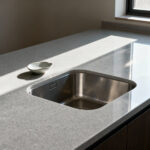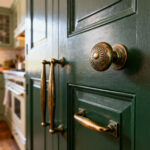Hey there, fellow home enthusiasts! Olivia here, ready to dive into the exciting world of DIY dining room makeovers. You know that feeling when you walk into a room and instantly feel like you’re on vacation? That’s the magic I want to help you create in your dining space. Today, we’re tackling a project that might seem as daunting as trying to paddleboard through a hurricane (trust me, I’ve been there!), but I promise it’s doable: installing dining room flooring.
Picture this: you’re hosting a dinner party, and as your guests step into your dining room, their jaws drop at the sight of your stunning new floors. Sounds pretty amazing, right? Well, get ready to make that vision a reality! Whether you’re dreaming of classic hardwood, chic laminate, or something unique, I’ve got you covered with all the tips and tricks you need to install dining room flooring like a pro.
Before we jump in, if you’re still on the fence about which flooring type is perfect for your space, check out our complete guide to dining room flooring. It’s packed with inspiration and practical advice to help you make the best choice for your home.

Ready to transform your dining room from “meh” to “marvelous”? Let’s dive in and make some waves in the world of interior design!
Choose the Right Flooring
Alright, amigos, let’s talk about choosing the perfect flooring for your dining room. It’s like picking the right swimsuit for a beach vacation – you want something that looks great, feels comfortable, and can handle whatever comes its way (spilled salsa, anyone?).
Understand Material Options
When it comes to installing dining room flooring, you’ve got options as varied as the fish in the sea. Hardwood brings that classic, “I’ve got my life together” vibe, but it does require a bit of TLC. Laminate is like hardwood’s cool, low-maintenance cousin – it looks similar but won’t throw a fit if you spill your margarita. And then there’s vinyl, the superhero of flooring – it can take on water, and heavy foot traffic, and still look fabulous.
If you’re leaning towards the timeless appeal of wood, you might want to explore our guide on dining room flooring using hardwood. It’s packed with everything you need to know about bringing that warm, natural beauty into your space.

Compare Pros and Cons
Let’s break it down like we’re planning a beach trip. Hardwood is like staying at a fancy resort – it’s gorgeous and long-lasting, but it’ll cost you more coconuts upfront. Laminate is your budget-friendly Airbnb – it looks great in photos and won’t break the bank, but it might not have the longevity of a five-star hotel. Vinyl is like that perfect beachfront condo – affordable, durable, and ready for anything, even if it’s not the most glamorous option out there.
Consider Room Usage
Think about your dining room’s lifestyle. Is it the party central of your home, always buzzing with activity? Or is it more of a quiet retreat for intimate dinners? High-traffic areas call for sturdy materials like tile or hardwood. If your dining experiences tend to be more… let’s say, “enthusiastic” (I’m looking at you, spaghetti night), you might want to consider water-resistant options like vinyl.
For those of you who love the look of wood but need something more resilient, check out our article on luxury vinyl plank for your dining room. It’s a game-changer for busy households!

Budget for Materials
Time to crunch some numbers! Measure your dining room like you’re fitting it for a custom swimsuit – every inch counts. This will help you estimate costs more accurately than a weather forecast. Don’t forget to factor in those “extras” like underlayment and adhesives – they’re the sunscreen of your flooring project, essential but often overlooked. And always set aside a little extra in your budget for unexpected expenses. Think of it as your “just in case we find a cute beachside café” fund.
Prepare the Subfloor
Alright, DIY warriors, it’s time to get down and dirty with subfloor prep. Think of this step as laying the foundation for a sandcastle – if it’s not solid, level, and smooth, your beautiful creation (or in this case, your new flooring) won’t stand a chance against the tides of time (or foot traffic).
Inspect for Damage
First things first, channel your inner detective and give that subfloor a thorough once-over. Look for any cracks, dips, or signs of water damage like it’s a game of “I Spy.” Trust me, spotting these issues now will save you from a “why is my floor creaking like a haunted house?” situation later.

Clean and Level Surface
Now, let’s get this subfloor cleaner than a beach after a community cleanup day. Sweep away all the debris, dust, and remnants of flooring past. If you find any uneven spots, it’s time to break out the leveling compound. Think of it as smoothing out the wrinkles in your beach towel – you want a nice, flat surface for maximum comfort (and in this case, a flawless flooring installation).
Address Moisture Issues
Moisture is like that one friend who always wants to crash your beach party – uninvited and potentially problematic. Test your subfloor for moisture levels, and if things are looking a bit damp, consider installing a vapor barrier. It’s like a raincoat for your floor, keeping everything nice and dry underneath.
Install Underlayment
Last but not least, roll out that underlayment like you’re unrolling your yoga mat for a beachside session. This layer is crucial for comfort, sound absorption, and overall flooring longevity. Make sure it’s smooth, with no wrinkles or bubbles, just like how you’d want your perfect beach day to be – smooth sailing all the way!

Gather Necessary Tools
Okay, DIY enthusiasts, it’s time to assemble your toolkit! Think of this as packing for the ultimate beach adventure – you want to be prepared for anything without lugging around your entire garage.
Essential Tools List
First up, the must-haves for your flooring installation mission:
- Tape measure (because eyeballing it is not a valid measurement technique, trust me)
- Saw (for those precision cuts – think of it as sculpting your floor to perfection)
- Hammer (for when gentle persuasion just won’t cut it)
- Pry bar (your best friend for removing old flooring – it’s like an intense game of Jenga)
- Spacers (these little guys are crucial for maintaining proper expansion gaps)
- Utility knife (for all those fine details – it’s the artist’s brush of flooring installation)
- Straight edge (because crooked lines are only cool in abstract art, not flooring)

Safety Gear to Wear
Safety first, amigos! Let’s gear up:
- Safety goggles (protect those peepers – you’ll want them intact to admire your handiwork later)
- Knee pads (trust me, your knees will thank you after hours of floor-level work)
- Proper footwear (leave the flip-flops for the beach – closed-toe shoes are your friends here)
Optional Tools for Ease
Want to level up your installation game? Consider these power players:
- Flooring nailer (for faster plank installation – it’s like the speedboat of flooring tools)
- Jigsaw (perfect for those tricky cuts around obstacles – think of it as navigating through a coral reef)
- Tapping block (helps secure planks without damaging them – gentle but effective, like a good exfoliating scrub)
Remember, having the right tools is like having the perfect beach setup – it makes the whole experience so much more enjoyable!

Measure and Plan Layout
Alright, design enthusiasts, it’s time to channel your inner architect and get planning! This stage is like mapping out the perfect spot on the beach – you want the best view, optimal sun exposure, and easy access to the snack bar (or in our case, a beautifully laid-out floor).
Accurate Room Measurement Tips
Let’s start by getting those measurements on point:
- Measure the room’s length and width with the precision of a master sandcastle builder.
- Don’t forget to account for any quirky corners, alcoves, or doorways – they’re like the hidden coves of your room.
- Double-check everything because, trust me, “measure twice, cut once” isn’t just a catchy phrase – it’s a DIY lifesaver!
Plan Layout for Aesthetics
Now, let’s talk strategy:
- Decide on the direction of your planks. It’s like choosing which way to face your beach chair – it can change your perspective!
- Stagger those seams between planks. Think of it as creating a natural, flowing pattern in the sand.
- Plan your transitions between rooms. You want your flooring to flow as smoothly as the tides, creating a cohesive look throughout your home.

Cut Planks to Fit
Time to make those planks fit like a glove:
- Mark your cuts with the care of an artist sketching a masterpiece.
- For those tricky angle cuts (hello, corners!), a miter saw will be your best friend.
- When dealing with obstacles like vents or door frames, measure twice and cut once. It’s like navigating through a tricky reef – precision is key!
Remember, a well-planned layout is the difference between “Oh, you installed new flooring” and “Wow, your dining room looks amazing!” Let’s aim for the latter, shall we?
Install the Flooring
It’s showtime, DIY superstars! Installing dining room flooring is like building the ultimate sandcastle – it takes patience, precision, and a bit of creative problem-solving. But don’t worry, I’ll guide you through each step like a pro beach volleyball coach.
Follow Installation Techniques
First things first, let’s lay down some ground rules (pun intended):
- Start from the longest wall in the room. It’s like finding the perfect spot on the beach to set up camp – it sets the tone for everything else.
- Keep your spacing consistent. Think of it as lining up your seashells in a perfect row – it’s all about that satisfying uniformity.
- Use spacers to maintain expansion gaps. These little heroes prevent your floor from buckling when the temperature changes, kind of like how you’d leave space between beach towels on a crowded day.

Secure First Row Properly
Getting that first row right is crucial – it’s the foundation of your entire flooring project:
- Align it perfectly parallel to your longest wall. It’s like drawing that first line in the sand – make it count!
- Use clamps to keep everything tight and in place. Think of them as the anchors for your beach umbrella – they keep everything steady.
- Double-check your alignment before securing. It’s like making sure your swimsuit is on straight before heading out to the beach – a quick check can save you from embarrassment later!
Handle Obstacles Smoothly
Every room has its quirks, just like every beach has its rocky patches:
- For door frames and vents, cut your planks with the precision of a sushi chef. It’s all about those clean, accurate cuts.
- Use templates for irregular shapes. It’s like using a cookie cutter to make perfect sandcastles – it ensures consistency and saves time.
- Don’t forget to seal around these obstacles. A good flexible sealant is like the perfect beach hair product – it keeps everything in place while still allowing for movement.

Add Trim and Molding
The finishing touches are what take your floor from “nice” to “wow”:
- Install baseboards to cover those expansion gaps. It’s like adding that final flag to your sandcastle – it completes the look.
- Consider using quarter-round molding for an extra polished finish. Think of it as the garnish on your favorite tropical drink – small but impactful.
- Secure everything carefully. You want your trim to stay put like a well-anchored beach umbrella, not blow away with the first gust of wind!
Finish and Protect the Floor
Congratulations, you’re on the home stretch of installing dining room flooring! Now, let’s make sure your hard work stands the test of time (and dinner parties). This final stage is like applying sunscreen at the beach – essential for long-lasting protection and beauty.
Seal for Longevity
First up, let’s seal the deal (and your floor):
- Choose a sealant that’s compatible with your flooring material. It’s like picking the right SPF for your skin type – crucial for proper protection.
- Apply it evenly, channeling the zen focus of a paddleboarder on a calm sea.
- Give it plenty of time to cure. Patience here is key – like waiting for a sandcastle to dry before adding those intricate details.

Clean Up After Installation
Time to tidy up like you’re packing up after a day at the beach:
- Remove all debris and leftover materials. Think of it as leaving no trace behind, just like a responsible beachgoer.
- Vacuum or sweep thoroughly. Get into all those nooks and crannies like you’re searching for hidden seashells.
- Dispose of waste properly. Many materials can be recycled, so check with your local waste management – it’s like separating your trash from your recyclables after a beach picnic.
Maintain Your New Floor
Keep that floor looking fab with some TLC:
- Establish a regular cleaning routine. It’s like maintaining your beach body – consistency is key!
- Use furniture pads to prevent scratches. Think of them as little life jackets for your floor, protecting it from the rough seas of chair legs and table corners.
- Choose cleaning products wisely. Harsh chemicals are a no-go, just like you wouldn’t use dish soap to wash off beach sand. Stick to cleaners designed for your specific flooring type.
Final Remarks
And there you have it, my DIY dynamos! You’ve just surfed through the complete guide to installing dining room flooring. From choosing the perfect materials to adding those final protective touches, you’re now equipped to transform your dining space into a showstopper.

Remember, installing new flooring is like creating the perfect beach day – it takes some planning, effort, and the right tools, but the result is worth it. Imagine the satisfaction you’ll feel hosting your next dinner party on a floor you installed with your own two hands. It’s not just a floor; it’s a conversation starter, a point of pride, and the foundation for countless memories to come.
So, what are you waiting for? Grab those tools, pick out your dream flooring, and dive into this project with the enthusiasm of a kid building their first sandcastle. Your dream dining room is just a floor installation away!
And hey, once you’re done, why not share your before-and-after pics? I’d love to see how your dining room transforms from “meh” to magnificent. Happy flooring, and may your new dining room floor be as smooth and inviting as a perfect sandy beach!






